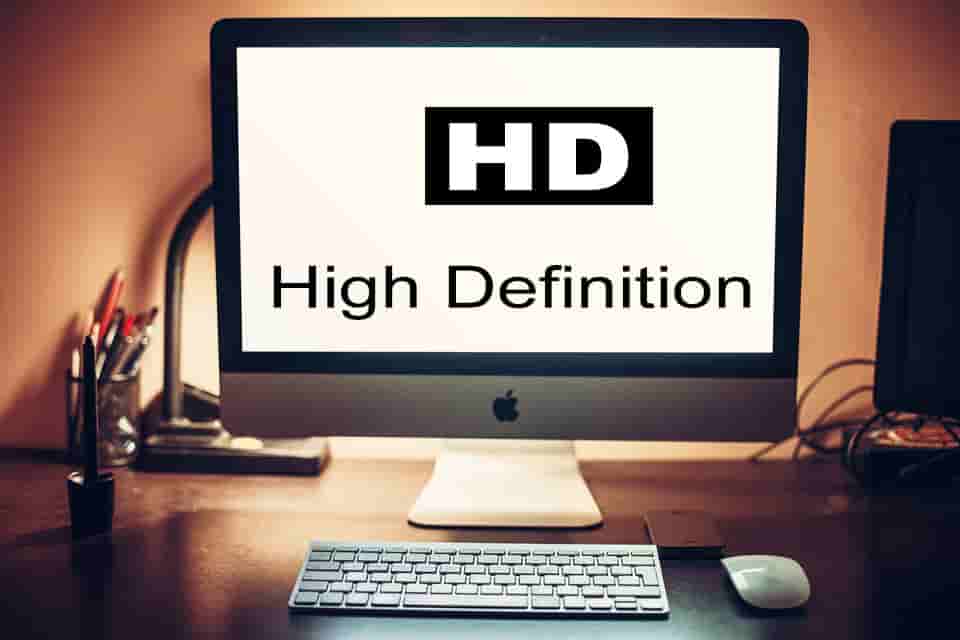HD is an abbreviation for High Definition. The term HD may also refer to a high-definition video content item, such as a video shot in HDV or a format of DVD or Blu-ray Disc data storage disk. High definition is a digital or analogue video signal with more than 720 lines of horizontal resolution.

Types of HD Content
High-definition (HD) content offers superior visual and audio quality compared to standard-definition (SD) media. It’s prevalent in:
- HDTV: Enhanced TV broadcasts, including sports, movies, and documentaries.
- Blu-ray Discs: High-quality optical discs for movies and TV series.
- Streaming Services: Platforms like Netflix and Amazon Prime with HD movies and TV shows.
- Gaming Consoles: HD gaming experiences on systems like PlayStation and Xbox.
- Online Video Platforms: HD content on YouTube and Vimeo.
- Digital Downloads: HD movies and shows from platforms like iTunes.
- Photography and Cameras: HD capture for photography and videography.
- Video Conferencing: HD video calls on platforms like Zoom.
- Documentaries: Stunning HD visuals in nature and educational documentaries.
- Sports: Enhanced HD broadcasts for sports fans.
The Advantages of HD
High Definition (HD) technology offers a plethora of advantages, enhancing the quality of visual and audio content across various media platforms. Here are some key advantages of HD:
- Sharper and Clearer Images: HD content provides significantly higher resolution, resulting in sharper and more detailed images. This improved clarity allows viewers to see fine details and textures in videos and images.
- Enhanced Viewing Experience: HD content offers a more immersive and enjoyable viewing experience. It’s especially noticeable in movies, sports broadcasts, and gaming, where the enhanced visuals create a more captivating atmosphere.
- Vibrant Colors: HD technology often supports wider colour gamuts, allowing for more vibrant and true-to-life colours. This makes content appear more realistic and visually appealing.
- Better Audio Quality: Alongside improved visuals, HD often includes superior audio quality, with options for surround sound and high-fidelity audio. This enhances the overall immersion in movies, games, and music.
- Reduced Pixilation: HD content reduces the visibility of pixelation, providing smoother edges and gradients. This is particularly beneficial when viewing large screens or sitting closer to the display.
- Compatibility: Most modern devices, from TVs to smartphones and gaming consoles, support HD content, ensuring accessibility for a wide range of users.
- Future-Proofing: As technology advances, HD continues to evolve with even higher resolutions and quality, ensuring that it remains relevant and adaptable for the future.
- Professional Use: HD is crucial in professional fields such as filmmaking, photography, and graphic design, where accuracy and detail are paramount.
- Streaming and Online Content: HD is now standard on many streaming platforms, delivering a high-quality experience for viewers streaming movies, TV shows, and videos online.
- Educational and Scientific Applications: HD technology is used in education and scientific research to provide clear visual representations, aiding understanding and analysis.
HD Resolution and Aspect Ratios
High Definition (HD) content features two main resolutions: 720p and 1080p, with a standard 16:9 aspect ratio.
- 720p (1280×720): Ideal for broadcasts and streaming, it offers a noticeable upgrade from standard-definition content.
- 1080p (1920×1080): Known as Full HD, it provides superior detail and is common in Blu-ray, HDTV, and streaming.
The 16:9 aspect ratio delivers a widescreen experience, fitting modern displays perfectly. Although some films use wider ratios for cinematic effects, HD’s 16:9 standard ensures consistent, high-quality visuals across devices, enhancing the viewing experience.
HD Display Technologies
HD display technologies, such as LCD, OLED, QLED, AMOLED, plasma, projectors, and Retina displays, offer superior image quality, vibrant colours, and immersive viewing experiences across devices. These technologies have revolutionized how we consume visual content, from high-end TVs to smartphones, redefining the standards for sharpness and clarity. Continuous advancements promise even better visual experiences in the future.
HD Devices and Accessories
The proliferation of High Definition (HD) generation has led to a big range of well suited devices and accessories designed to decorate the HD enjoy across numerous platforms. These gadgets consist of:
1. HD TVs and Monitors: The centrepiece of HD amusement, these shows provide stunning visuals with sharp resolution and colourful colourations. LED, OLED, QLED, and 4K UHD TVs are a few popular options.
2. Blu-ray Players: Designed to supplement HD content material, Blu-ray players supply remarkable video and audio playback for movies and TV series in Full HD and 4K codecs.
3. Gaming Consoles: Modern gaming consoles like PlayStation and Xbox help HD gaming, imparting immersive and practical portraits for gamers.
4. HD Projectors: Ideal for home theatres, HD projectors offer huge-screen experiences, delivering cinematic visuals for movies and gaming.
5. Sound Systems: HD audio enhances HD video, and sound structures like soundbars and home theatre setups make certain an immersive auditory experience.
6. Streaming Devices: Streaming media gamers like Roku and Amazon Fire TV offer HD streaming capabilities, allowing them to get entry to HD content from streaming systems.
Conclusion
In conclusion, High Definition (HD) era has revolutionized the manner we experience and interact with visible and audio content material across various structures. From the crystal-clear snapshots on our HD TVs to the immersive gaming studies on HD video display units and consoles, HD has set a new well known for excellent and precision.
FAQs About HD
HD, or High Definition, refers to the technology that provides superior visual and audio quality compared to standard-definition (SD). It delivers sharper images, vibrant colors, and enhanced clarity.
The most common HD resolutions are 720p (1280×720 pixels) and 1080p (1920×1080 pixels). These resolutions are used in HD TVs, monitors, and content.
Many devices support HD content, including HD TVs, Blu-ray players, gaming consoles, smartphones, tablets, and computers. Additionally, streaming devices and projectors can provide HD experiences.
HD has a resolution of either 720p or 1080p, while 4K, also known as Ultra High Definition (UHD), has a resolution of 3840×2160 pixels. 4K offers four times the resolution of HD, resulting in even sharper and more detailed images.
Related posts:
- AMC Full Form: Benefits, Components, Needs, Advantage
- ORS Full Form: Dehydration, Myths, Flavors, Varieties & Facts
- PCC Full Form: Importance, Types, Application Process
- PAN Full Form: Legal Provisions, Regulations,
- BRB Full Form: Productive, Routine, Distractions
- MCD Full From: Introduction, Responsibility, Challenges
- CT Scan Full Form: Scans, price, Advantages
- USA Full Form: History, Economics,Technology, culture




















